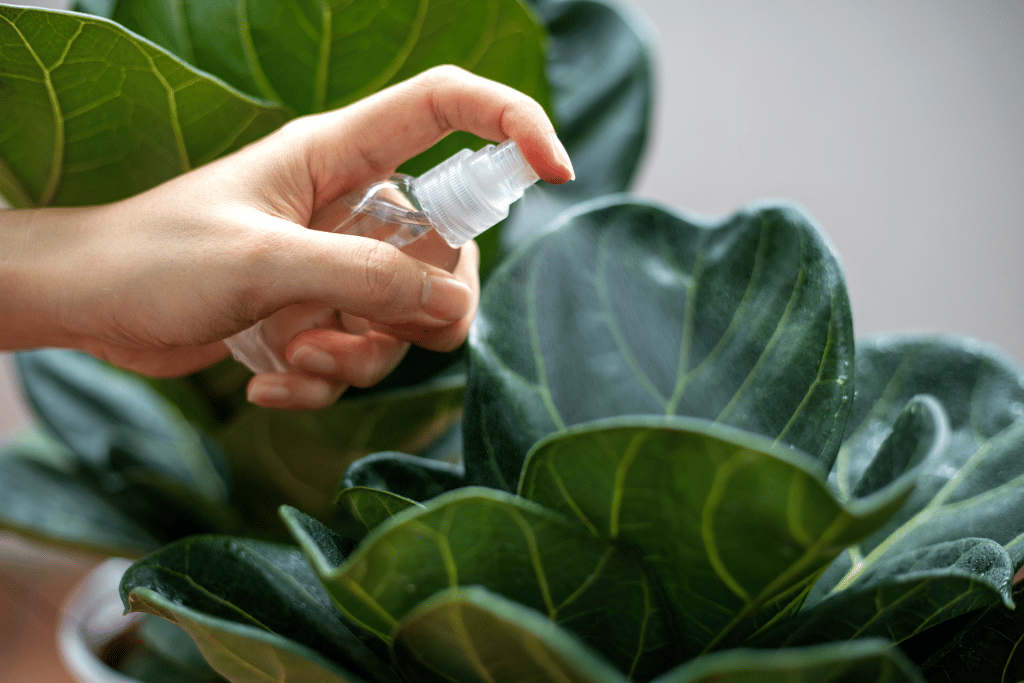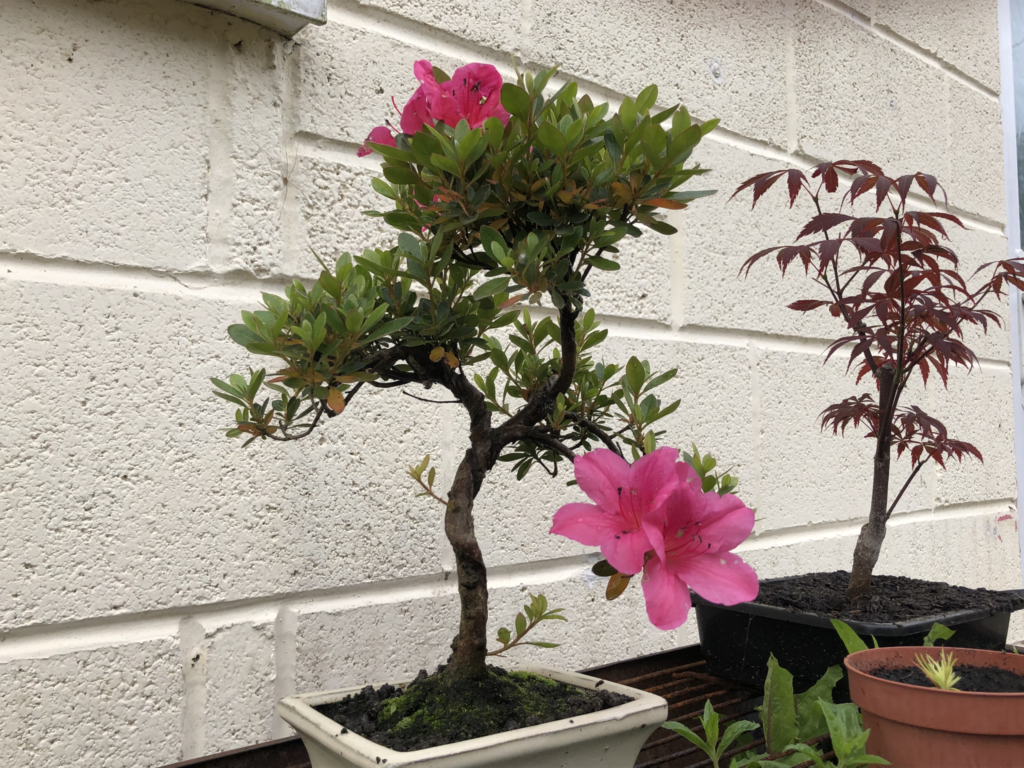Watering is a crucial aspect of caring for any plant, including the fiddle leaf fig (Ficus lyrata). The fiddle leaf fig is a captivating and popular houseplant most commonly known for its large and glossy leaves. Making sure that we find the right balance and frequency of watering is essential in making sure that our plants grow well and are in good health. In this detailed article, we’ll explore some of the factors that will influence the watering needs of a fiddle leaf fig, providing guidelines to help you understand how often to water this beautiful species of plant.

Understanding the Watering Needs of a Fiddle Leaf Fig
1. Soil Moisture and Drainage
A good potting medium is essential for most houseplants. It will completely make the difference between a healthy or sick plant. Fiddle leaf figs prefer a well-draining soil mix, which retains some moisture without becoming waterlogged. This is important, as excess water needs to drain away to prevent root rot and other water-related issues such as the growth of nasty bacteria. Your plants should not stand in water for long periods of time. Before watering your plants, you should ideally check the moisture level of the soil by feeling it. If the top inch or two of the soil is dry, then it’s time to water – if not, then I would hold off on watering until it is.
2. Environmental Factors
Several environmental factors will influence the watering requirements of a fiddle leaf fig, including light exposure, temperature, humidity and air circulation.
- Light Exposure: Fiddle leaf figs like to be in a place with bright and indirect light. The intensity and duration of light exposure will influence the plant’s water requirements. Plants which are kept in brighter locations will typically require more frequent watering compared to those in low-light conditions.
- Temperature: Plants kept in warmer temperatures will generally increase a plant’s watering needs, as higher temperatures will lead to the faster evaporation of water from the soil and foliage of the plant. If your plant is kept somewhere warm, I would recommend misting it frequently to help it deal with the temperature better.
- Humidity: Fiddle leaf figs will thrive in environments with moderate to high humidity. In lower humidity environments, the plant will likely require more frequent watering or additional ways of increasing humidity, such as using a tray of water near the plant, frequently misting or a humidifier.
- Air Circulation: Good air circulation between your plants will help to prevent the buildup of excess levels of moisture, allowing the soil to dry out properly between waterings. Adequate air movement will help to reduce the risk of fungal diseases manifesting, enhancing your plant’s overall health.
Determining the Frequency of Watering

To determine how often you should water your fiddle leaf fig, it’s best to consider the following factors:
1. Soil Moisture Test
You can perform a soil moisture test by simply inserting your finger an inch or two deep into the soil. If the soil feels dry at that depth, then it’s a sign that the plant may need watering. If the soil still feels moist, then it would be better to wait to avoid overwatering your plant and causing further problems.
2. Weight of the Pot
Another way to gauge the watering needs of your plant is by feeling how heavy the pot is. When the soil is dry, you’ll notice that the pot will typically feel lighter, showing that it’s time to water it. Lift the pot gently to get a sense of the weight when the soil is adequately dry, and then compare it to the weight after you water it. This method will help you to develop a sense of when your plant needs watering over time.
3. Leaf Condition
Leaves are typically quite a good sign in telling when your fiddle leaf fig needs watering. If the leaves start to appear droopy, limp or a dull appearance, then this is typically a sign of underwatering. Yellowing leaves or signs of root rot may suggest that it is overwatering your plant is suffering from – so it’s best to monitor the condition of your leaves regularly. Adjust your watering routine of your plants accordingly based on leaf health.
General Guidelines for Watering A Fiddle Leaf Fig
While the frequency of watering can vary due to many different individual factors, let’s go over some general guidelines to help you establish a reliable watering routine for your fiddle leaf fig and other plants.
- Water thoroughly: When it is time to water your fiddle leaf fig or any of your houseplants, ensure that you thoroughly water the soil until water drains out of the bottom of the pot. This will make sure that water reaches the root ball, flushing out any residue or accumulated salts. Don’t give only a few drops of water to your plant when it’s time to water – this will damage it.
- Allow for proper drainage: After watering, make sure that any excess water that accumulates in the drainage tray or saucer is emptied to make sure that the plant doesn’t sit in standing water, which can lead to root rot or other water-based problems.
- Observe any seasonal changes that occur: You will find that adjusting your watering frequency will depend massively on seasonal changes. Fiddle leaf figs will require less frequent watering in the winter months when growth slows down and the plant’s water needs start to decrease. Similarly, when it gets to the growing season in spring and summer, you’ll find that the water demand suddenly increases again.
- Consider pot sizes: Larger pots will tend to retain a lot more moisture than smaller pots; so it’s best to keep your plant in an appropriately sized pot and don’t overpot them. If your fiddle leaf fig is in a larger pot, it’s likely that you’ll have to water it less frequently. Though, you should ensure that the pot has proper drainage holes to prevent any waterlogging from occurring or standing water.
- Avoid overwatering. Generally, overwatering may take a while longer to kill your plant than underwatering. Though, it’s better to slightly underwater fiddle leaf figs than to overwater, as the plant can be more tolerant of slight drought conditions rather than excessive moisture. It’s best to err on the side of caution though, allowing the soil to dry out between waterings. I wouldn’t recommend ever letting the soil of your plants completely dry out though, as this can have irreversible effects.
Monitoring and Adjusting Your Watering Routine

Monitoring your fiddle leaf fig’s response to watering is essential, and making adjustments is necessary. Pay attention to how your plant regularly looks and feels, and consider any environmental conditions you are exposing it to. It’s best to try and keep conditions stable, as any drastic changes can harm the plant. Regularly assess the moisture of the soil, leaf condition and overall health of the plant.
Make sure to remember that the frequency of watering can vary throughout the year due to things such as temperature fluctuations, shifting light conditions and seasonal changes. Gaining experience with your specific fiddle leaf fig will help you to develop a better understanding of their unique watering requirements.
Final Thoughts
Proper watering is essential to maintaining the health and growth of any houseplant; fiddle leaf figs included. Understanding the factors which can influence watering needs such as the soil moisture, environmental conditions and the plant’s response to such will allow you to establish an effective and reliable watering routine. By performing soil moisture tests, observing leaf conditions and considering factors like humidity, temperature, light and air circulation, you should accurately be able to determine how often to water your fiddle leaf fig.
Remember to adjust your watering routine as necessary, ensuring that the soil remains slightly moist but not too overly saturated. With attentive care and proper watering, I’m sure that your fiddle leaf fig will flourish beautifully and become a focal point in your indoor garden.
Frequently Asked Questions (FAQ)
Should I use tap water or filtered water for watering my fiddle leaf fig?
While fiddle leaf figs are generally tolerant of tap water, they can be particularly sensitive to certain minerals and chemicals that are often present in tap water, such as chlorine and fluoride. If your tap water has high levels of these chemicals or if you notice leaf browning, tip burn or chlorosis, you should consider using filtered water. Filtered water will help to remove these impurities that could affect the plant’s health. There are many ways to do this, but an easy way is to simply let the tap water sit for a while so that the chemicals evaporate.
Can I use water collected from a dehumidifier to water my fiddle leaf fig?
Water collected from a dehumidifier can be used to water your fiddle leaf fig, but make sure that it’s clean and free of any contaminants or additives. Keep in mind that water from a dehumidifier will tend to be distilled and lack essential minerals, so if you do choose to use this water then consider supplementing occasionally with water that contains natural minerals. You can also use a balanced, water-soluble fertilizer to provide necessary macronutrients such as nitrogen, phosphorous and potassium and many micronutrients.
How do I know if I am underwatering or overwatering my fiddle leaf fig?
Typical signs of underwatering include symptoms such as dry and crispy leaf edges, drooping leaves and soil that feels very dry to the touch. Overwatering signs include leaf drop, mushy stems, yellowing leaves, soil that remains constantly wet and discolored/brown roots. Assess the soil moisture regularly, leaf condition and overall health of the plant to determine if any adjustments need to be made to your watering routine.
Can I use a moisture meter to determine when to water my fiddle leaf fig?
Moisture meters can also be helpful tools to determine when you should water your plant. It will provide a more accurate way of telling when to water, instead of using guesswork. Simply insert the probe into the soil, noting the moisture reading. I would recommend using the moisture meter as a guide though, not solely relying on it. Additionally, make sure to insert the probe into different locations around the root zone to get a more comprehensive and accurate understanding of the soil’s moisture.



